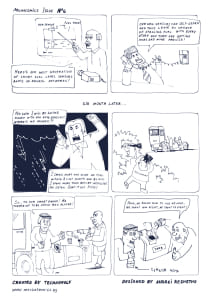Onboard weighing system is a highly demanded option among GPS tracking provides as the system helps to avoid heavy fines for overload, prevent cargo theft and unauthorized fleet usage. Due to the relative novelty of the solution, it is not so wide-spread, that gives an integrator a chance to stand out among competitors.Let’s talk about the crucial points of onboard weighing system’s installation and integration. Basically, there are two possible ways to calculate axle load and cargo weight
1. Server-based calculations. All possible calculations can be made on GPS tracking platform’s side. In this case, onboard hardware consists of a GPS tracker and axle load sensors only.
- GPS tracker
- Axle load sensor (leaf spring)
- GPS tracking platform
2. Onboard-based calculations. Let us say that customer’s requirements include onboard display with actual axle loads, gross and net cargo weight. It means we have to calculate all data onboard. The first generation of axle load sensors had only analog output. Thus the solution for a large number of axles and sensors required the introduction of an ADC module – eurosens Difference-T. The module is used to convert voltage to digital messages in RS485 or CAN bus.
Onboard weighing system components with onboard calculation (1st generation)
- GPS tracker
- Display
- Difference-T units
- Axle load sensor (leaf spring)
- GPS tracking platform
- Onboard weighing with Difference-T
Latest axle load sensors already have RS485 or CAN bus interface. So you can connect any number of sensors directly to the GPS tracker using RS485 or CAN bus. Eurosens Display will collect data from all sensors, calculate total and cargo weight and provide data to the GPS tracker.
- GPS tracker
- Display
- GPS tracking platform
- DPS CAN
How can we calculate the cost of the solution? The main factor here is the number of axle load sensors to be installed. Let’s go through the short questionnaire:
1. How many axles are there in a vehicle (and trailer)?
2. How many lifting axles are there?
3. Which type of cargo does the vehicle carry? The type of cargo defines the type of its distribution. See the difference between the even (front-rear, left-right) and a random distribution (the cargo can be placed anywhere).
The truck with even distribution requires only ONE sensor installed in the middle of the rear axle (one of rear axles). The vehicle with a random cargo distribution requires 2 sensors (front and rear) installed in the middle of the truck (otherwise, add left-right sensor).
Which accuracy can we get?
For leaf spring suspension axle load can be calculated with 5-7% error from the maximum axle load. And total vehicle load can be calculated with 5-10% error from vehicle’s gross weight (or vehicle + trailer).
For air spring suspension: 2-3% error of the maximum axle load and 3-5% error from vehicle’s gross weight.
Example: Unloaded vehicle has 5000 kg weight, while loaded – 12000 kg. Measurement error for empty and full state will be approximately the same: +/-600-1200 kg error for empty and full state (leaf spring suspension vehicle) and +/- 240 kg (for air spring suspension).
Examples of axle load data:
- axle loads (air spring)
- axle loads (leaf springs)
When a customer has a large fleet of vehicles with onboard weighing we highly recommend to create a special report instead of just axle load and cargo weight visualization.
Mechatronics’ team is working on adding extra features for on-board weighing, thus we’ve created several special modules for a popular Wialon GPS tracking platform. One of them is for dump trucks and second one for garbage trucks.
Let’s check together the example of axle load data (leaf spring suspension). The green plot – cargo weight, the rest plots are axle load and speed.
Due to leaf spring nature we can’t use these data directly but smart data processing we can receive good results.
For example, Wialon trip reports use only one point of sensor data at the beginning/end of the trip. We need to average cargo weight data during the whole trip. So, based on this idea we create a special app which performs the following functions: 1
. Reads all sensors data from Wialon for a desired period of time.
2. Load/Unload events recognition, detects start and end of the cargo trip.
3. Calculates average cargo weight values (and some other smart processing as well).
4. Creates a web report and excel report. Web report is interactive, places of load/unload events are clickable and show the event’s position on the map.
Why do we need different modules for different vehicles?
Different logic of operation leads to different Wialon applications: compare the data from dump truck and garbage truck. We cannot detect small loadings of waste truck with leaf spring suspension.
- axle loads (leaf springs)
- GPS tracking platform
So, GPS tracking platform report will have another format:
Conclusion
The onboard weighing system can become a very effective extra feature for a GPS tracking provider. But to get the desirable result we should understand customer’s requirements and hardware limitations (for trucks with leaf spring suspension). New Eurosens axle load sensors with digital interface reduces the total cost of advanced onboard weighing system for truck+trailer combinations with a large number of axles. One of the most important things is proper software, because even powerful Wialon does not have built-in tools to manage onboard weighing data in a report format. That’s why we have created our own Wialon-Apps. The same data-processing idea should be implemented in other GPS tracking platforms for onboard weighing integration for large fleets.


























We are in social media
Facebook
LinkedIn
Youtube